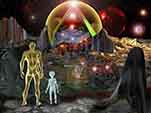By Tony Cartalucci
UK Proscribed terrorist organization, Libyan Islamic Fighting Group (LIFG), maintains large presence in Manchester area and is now being linked to recent blast.
As suspected and as was the case in virtually all recent terror attacks carried out in Europe – including both in France and Belgium – the suspect involved in the recent Manchester blast which killed 22 and injured scores more was previously known to British security and intelligence agencies.
The Telegraph in its article, “Salman Abedi named as the Manchester suicide bomber – what we know about him,” would report:
Salman Abedi, 22, who was reportedly known to the security services, is thought to have returned from Libya as recently as this week.
While initial reports attempted to craft a narrative focused on a a “lone wolf” attacker who organized and executed the blast himself, the nature of the improvised explosive device used and the details of the attack revealed what was certainly an operation carried out by someone who either acquired militant experience through direct contact with a terrorist organization, or was directed by a terrorist organization with extensive experience.
A Thriving Terrorist Community in the Midst of Manchester
The same Telegraph article would also admit (emphasis added):
A group of Gaddafi dissidents, who were members of the outlawed Libyan Islamic Fighting Group (LIFG), lived within close proximity to Abedi in Whalley Range.
Among them was Abd al-Baset Azzouz, a father-of-four from Manchester, who left Britain to run a terrorist network in Libya overseen by Ayman al-Zawahiri, Osama bin Laden’s successor as leader of al-Qaeda.
Azzouz, 48, an expert bomb-maker, was accused of running an al-Qaeda network in eastern Libya. The Telegraph reported in 2014 that Azzouz had 200 to 300 militants under his control and was an expert in bomb-making.
Another member of the Libyan community in Manchester, Salah Aboaoba told Channel 4 news in 2011 that he had been fund raising for LIFG while in the city. Aboaoba had claimed he had raised funds at Didsbury mosque, the same mosque attended by Abedi.
Thus, the required experience for the recent Manchester attack exists in abundance within the community’s Libyan Islamic Fighting Group (LIFG) members.
LIFG is in fact a proscribed terrorist group listed as such by the United Kingdom’s government in 2005, and still appears upon its list of “Proscribed terrorist groups or organisations,” found on the government’s own website.
The accompanying government list (PDF) states explicitly regarding LIFG that:
The LIFG seeks to replace the current Libyan regime with a hard-line Islamic state. The group is also part of the wider global Islamist extremist movement, as inspired by Al Qa’ida. The group has mounted several operations inside Libya, including a 1996 attempt to assassinate Mu’ammar Qadhafi.
Thus, astoundingly, according to the Telegraph, a thriving community of listed terrorists exists knowingly in the midst of the British public, without any intervention by the UK government, security, or intelligence agencies – with members regularly traveling abroad and participating in armed conflict and terrorist activities before apparently returning home – not only without being incarcerated, but apparently also without even being closely monitored.
LIFG also appears on the US State Department’s list of Foreign Terrorist Organizations. Astoundingly, it appears under a section titled, “Delisted Foreign Terrorist Organizations,” and indicates that it was removed as recently as 2015.
Elsewhere on the US State Department’s website, is a 2012 report where LIFG is described:
On November 3, 2007, [Al Qaeda (AQ)] leader Ayman al-Zawahiri announced a formal merger between AQ and LIFG. However, on July 3, 2009, LIFG members in the United Kingdom released a statement formally disavowing any association with AQ.
The report also makes mention of LIFG’s role in US-led NATO regime change operations in Libya in 2011 (emphasis added):
In early 2011, in the wake of the Libyan revolution and the fall of Qadhafi, LIFG members created the LIFG successor group, the Libyan Islamic Movement for Change (LIMC), and became one of many rebel groups united under the umbrella of the opposition leadership known as the Transitional National Council. Former LIFG emir and LIMC leader Abdel Hakim Bil-Hajj was appointed the Libyan Transitional Council’s Tripoli military commander during the Libyan uprisings and has denied any link between his group and AQ.
Indeed, a literal senior Al Qaeda-affiliate leader would head the regime put into power by US-led military operations – which included British forces.
Not only this, but prominent US politicians would even travel to Libya to personally offer support to Bil-Hajj (also spelled Belhaj). In one notorious image, US Senator John McCain is seen shaking hands with and offering a gift to the terrorist leader in the wake of the Libyan government’s collapse.
The US State Department’s report regarding LIFG ends with information about its “area of operation,” claiming (emphasis added):
Since the late 1990s, many members have fled to southwest Asia, and European countries, particularly the UK.






































